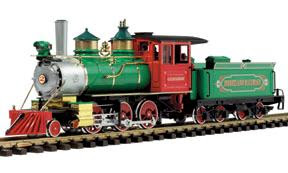 |
| Courtesy of Only Trains |
"Mogul locomotives were used by the Colorado & Southern on its spectacular narrow gauge line. On the smoke stack, this loco has a “Bear trap” spark arrestor to prevent fires in the heavily forested mountains. The model features authentic steam sound (with remote control features on Multi-Train System layouts), directional lighting, a smoke generator and a flickering light in the firebox."
LGB made 800 of these and nowhere (!) did they advertise the 23194 as Limited Series. This Mogul made the front page of the "2002 Summer Special" flyer. In addition the flyer did offer 12 more items - locos and cars - on 2(!) pages.
These were the signs of the times to come. LGB factory in Nuremberg had just reduced working hours - in Germany a decision that requires by law union consent, triggering grave consequences for employer and employees. Cash flow problems, continually decreasing sales, and on-going miserable management decisions were becoming more and more visible in the product program of LGB. The next Mogul to be offered "exclusively" for the US- market is another good example:
The LGB # 24194 , the "Baltimore and Ohio" in dark silver grey,black and dark blue. Just 399 were made, intended only (!) for the US market/ LGBoA. Were there too many 'specials'? Did advertising not reach the customer? Was the price too high for an engine not made well enough (maybe already manufactured partially in China?). LGB changed their mind about 'exclusivity' and in 2005 offered the # 24194 to the LGB eXtra partners for Euro 1,110.00 (about US$ 990.00).
 |
| Courtesy Only Trains |
Of the No. 97 LGB made 791 engines. The # 26192 came in an edition volume of 600. Four different Moguls in one year in very small batches......(though the # 26194 wasn't available at dealers before 2003/4)
But wait, this would be topped! The LGB # 22184 DISNEYLAND, "C.K.HOLLIDAY" was -- NO!--could have been without a doubt the outstanding loco of 2004. The edition volume was - drum roll please - 291. No kidding! 291 Disney Moguls # 22184 were made in 2004 and no more. Original MRSP was Euro 1,199.00 or about US$ 900.00.
 |
| Courtesy Only Trains |
The advertising copy in the LGB brochure 2004 DISNEY reads:"To make sure his railroad was ready to operate for the inauguration
of Disneyland on July 17, 1955, Walt Disney had his first two locomotives
built in his studio workshops. One, the ”C. K. Holliday,” was named
after the founder of the Santa Fe Railway, an early sponsor of the
Disneyland Railroad. An almost identical copy of the ”C.K. Holliday”
was later built for Disneyland Paris. This LGB model wears the loco’s
current livery and is equipped with digital sound, including steam
sounds and actual Disneyland station announcements!"
The Mogul was followed in the brochure by two Disney cars, the LGB #33803 (the "Lilly Belle") and the LGB # 33804 (the "Long Island") which were offered separately. The "Lilly Belle" is the name of the actual (Disney) parlor car as well as the name of the Disney Mogul loco at Walt Disney World Railroad At Walt Disney Park, Florida.
 |
| The Original Lilly Belle Mogul at Disney World Railroad |
Champex-Linden, a very fine German dealer in all things LGB has a wonderful link on the web showcasing this old LGB brochure featuring the Disney loco and car offer. Here is the link https://www.champex-linden.de/download_fremddokumente/lgb_2004_disneyland_00710.pdf
As you can see, the brochure is a hodgepodge of Disney related 'train' stuff. Something no Mogul ever deserved.
To give our dearest reader a little something to smile about - after all these sad LGB developments: a Japanese metal/iron Mogul in HO(n3), a true antique (not available and not in Klaus' possession)
+++++++++++++++++++++++++++++++++++++++++++++++++to be continued with the conclusion of the Mogul series.
See Klaus' latest offer from his personal collection at https://traincrafttrove.blogspot.com


































